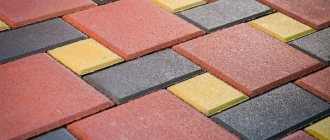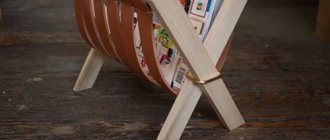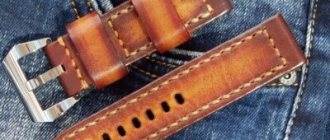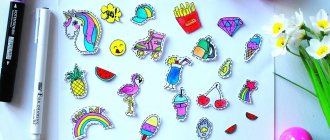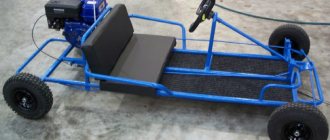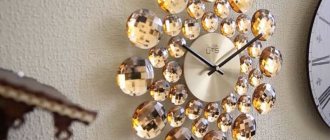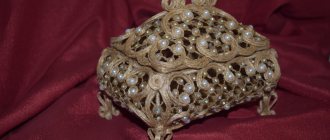Desk organizer stand
To create a tabletop stand, you don’t need to look for expensive blanks in specialized stores. It is quite possible to make do with improvised means.
What can it be made from?
The design of the stand directly depends on your imagination. Most often it is made in the form of a glass or several containers of different sizes. The following available materials can be used.
Attention! The depth of the stand for combs should be at least 10 cm so that they do not fall out. The model itself should have a wide bottom or be quite heavy, since large combs can overwhelm a light container.
Making a stand for combs
A stand made of three boxes connected to each other will be practical and compact.
Materials
For manufacturing you will need the following.
Operating procedure
Initially, we select boxes or make them ourselves from thick cardboard. The most convenient base sizes:
We paste the first two boxes with one color, and the smallest one with another. If you are using wallpaper, you can paste over two blanks, placing the pattern horizontally and vertically on one blank .
Attention! To ensure that the paper does not peel off and is less likely to bulge, fold the edges of the decor inside the container and secure them there with glue.
Important! The box for large combs should be located in the center so that the organizer does not fall over.
There can be any number of small sections, and you can store not only combs, but also hairpins in them.
Sponge holders for washing dishes
join the discussion
Share with your friends
Stands for sponges for washing dishes, as modern life shows, are not a fad, but a completely useful thing. Therefore, many people will be very interested in reading a review of kitchen holders for sponges and detergent. “Frogs” and other models are presented on the Russian market, but if you don’t want to buy anything at all, you can make such a thing yourself.
Wall mounted comb organizer
An organizer for combs located on the wall next to the mirror is a very practical solution.
Materials that may suit the organizer
The organizer is located on the canvas. Thick fabrics, knitted fabric, plywood, and plastic boards are suitable for it
The pockets are placed in a convenient order and secured with glue, thread or nails. They come from absolutely any material. If the base is hard, then it is better to use small boxes attached with glue or nails for pockets.
How to make a wall organizer
Denim is a great material for a wall organizer .
Source
On the door
Another simple device is a hanging shelf that is attached to the door of the kitchen cabinet. You can make it yourself or buy it in a store. If you hang the shelf from the inside, unsightly little things will be hidden from view, and if you fix the holder from the outside, the sponges will dry much faster.
Disadvantage: heavy load on the sash and constant exposure to moisture. If you are not sure about the quality of the fastening and material, we recommend finding another storage method.
Fabric organizer options
There are different types of storage organizers. They differ in the area of their use, the form of fasteners, and for what purpose they are used.
Depending on whether the module will move in space or not, they are divided:
The following types are determined by the type of fastener:
If we consider models created to contain a certain group of objects, we distinguish:
List of original ideas for an organizer:
Idea 7. Wall panel
Another craft idea for the home and kitchen that you can make with your own hands from wine corks is a wall panel for decorating the interior and storing notes, memorable photos and postcards.
Framed cork panel from Ikea
To work, you will only need a beautiful frame (from a picture or a mirror), paint of the desired color, hot glue and a large pile of corks. Corks can be laid out in a herringbone pattern, in a checkerboard pattern, in even rows, and in other ways that you like. If necessary, for example, if there are not enough corks, they can be cut lengthwise or crosswise. To make the corks easier to cut, you need to soak them in hot water for 10 minutes.
Find other interesting ideas for making wall panels with your own hands here.
MK sew an organizer for needlework with your own hands step by step
2. With exactly the same dimensions, I cut out one rectangle from quilted padding polyester. It will serve as a substrate and give a rigid shape to the base of the organizer.
3. Putting padding polyester between the pillowcase teak. Layers: teak - padding polyester - teak.
4. I fasten all three fabrics together with pins. Now you need to quilt them. I draw a pattern for quilting with a marker (pencil).
5. I sew on a machine along the lines. I make sure to make fastenings at the beginning and end of the lines so that the line does not unravel later.
6. I take the bias tape and smooth one edge with an iron.
8. I go around the corners, slightly rounding the bias tape.
9. I overlap the edges of the bias tape.
10. Trim excess fabric
11. I fold the bias tape over to the right side. I sew the free edge of the binding to the base of the organizer using hand running stitches.
12. I sew on the bias tape. Notice how I laid the fabric in relation to the machine foot. The stitching should go 1 mm. from the edge of the bias tape.
13. I cut out two pockets - a rectangle with sides 32 * 13 cm. I trim the upper edges with bias tape. I overlock the remaining open sections with an overlocker (zigzag).
14. I bend the edges of the pockets 1 cm inward. I stitch on a typewriter.
15. I measure 5.5 cm from the bottom of the organizer base and draw a line across with a marker
16. I attach the bottom pocket to the drawn line, as shown in the photo. I make a fold on both sides.
17. I sew the bottom pocket on the machine, retreating from the edge by the width of the foot.
18. I measure 19 cm from the top of the base. I draw a line with a marker. I sew the top pocket on the machine along this line.
19. I turn the pocket pieces right side up. I attach the pocket details to the base of the organizer on the sides over the existing stitching.
20. I ended up with three pockets at the top and two at the bottom. You can do the same. Or you can come up with your own version.
21. I cut 3 pieces of grosgrain ribbon. I burn the ends with matches to prevent them from unraveling.
22. I pin pieces of tape onto the base and secure with pins.
23. I sew the ribbons on the front side using a machine.
24. I insert a wooden pipe into the resulting holes. This is all I have on hand for now; the pipe from Bethlehem came in handy) I tie a cord to the pipe. Ready!
Sewing a handicraft organizer from Aliexpress with your own hands turned out to be not difficult. For a beginner, this creative process will be interesting, because here you can give free rein to your imagination. And the thing is very useful; in the same way you can sew a shoe organizer for your closet; Can be used for masks, gels, shampoos and other things in the bathroom or on the dressing table.
And the thing is very useful; in the same way you can sew a shoe organizer for your closet; Can be used for masks, gels, shampoos and other things in the bathroom or on the dressing table.
Idea 2. Jute coasters
If your kitchen (or, for example, a country or summer kitchen) is decorated in a rustic, Mediterranean, rustic or nautical style, then you will probably love this kitchen craft idea. In just a couple of hours you can make coasters for plates for the whole family and guests with your own hands.
To make one substrate with a diameter of 33 cm you will need:
- 10 meters of jute rope 1 cm thick (sold in construction and hardware stores);
- Hot glue gun;
- Scissors.
Just start rolling the rope in a circle, applying glue to small sections one by one and fixing them for a while. Once the mat is formed, cut the end of the rope and glue it down.
How to sew it yourself
If for some reason you are not satisfied with the purchased product, you can sew an organizer with your own hands, practically without a pattern. Below are master classes that will help you with this.
Preparatory stage
We decide on the location for attaching the sachet; the size of the future product depends on this. The width of the accessory should not exceed the dimensions of the crib wall on which it will hang.
The fabric for the pockets should be dense, hold its shape well, not fade or shrink. The color depends on your preference. It can be either bright or calm, pastel. Bright print or plain fabric - it's up to you.
Let's start with the simplest thing - small bags with flat sections.
1. Cut several rectangles from fabric: 2 pcs. 60x4 cm – these are ties, 4 pcs. 30×12 cm – pockets, 2 pcs. 30x40 cm – base (see the photo below for guidance).
2. Folding the edges inward, sew the back and front parts of the base, leaving the top unstitched. We lay the line as close to the edge as possible.
3. Fold the ties in half lengthwise and iron them. We bend the edges to the middle, iron them again, and fold them so that the edges are inside. We sew along the entire length. We make pockets like the base, but we lay the stitching along the entire perimeter.
4. Insert the double-folded ties into the unsewn part of the base and stitch them together.
5. Stepping back 9-10 cm from the top, sew on the first pocket. At the very bottom we have the second one.
6. Place a stitch exactly in the center from top to bottom. Thus, instead of two compartments we get four.
Now you can hang the sachet on the crib and fill it with the necessary little things.
If you are confident in your abilities, you can sew a model with voluminous sections and lace ruffle trim.
For this model you will need the following:
1. Cut out a 60x60 cm rectangle from the main fabric. We do the same with padding polyester.
2. Pockets are cut with allowance for folds: for the bottom two rectangles 66x23 cm, for the top - 70x22 cm.
3. We decorate the upper and lower sections with bias tape.
4. Fold the face part and the seal, marking the places where the pockets will be located. There is a distance of 7 cm between the lower and upper tiers.
5. Let's start with the pockets. Divide the strips into the required number of parts. We lay the seam according to the outline. Next, we sew on the bottom sides, making folds in the right places for volume.
6. Lay the lace ribbon.
7. It turns out like this.
8. Place the front part on the back part. We make sure that the lace is tucked inside. Sew along the sides and bottom.
9. Turn it inside out and carry out heat treatment.
10. We make ties in the same way as in the previous MK.
11. Bend the finished ties in half. We sew up the top of the sachet, having previously inserted fastening parts between the layers.
We hang it on the crib and admire the job well done.
Idea 3. Organizer for cutlery and kitchen utensils made from cans
Tin cans cost nothing, but they are durable, easy to clean, and their shape is just right for storing all kinds of spatulas, ladle, forks, spoons and other utensils. If you put in a little effort and creativity, you can make a convenient and cute organizer out of them, which, even if it doesn’t fit into the interior of a city kitchen, will definitely fit in at the dacha. You can also use an organizer made with your own hands from cans to store tools, brushes, felt-tip pens and other small items.
Stand for spoons and forks made from cans
To make such a stand for spoons and forks, you will need:
- 4 or 6 clean and dried cans, without lids or burrs;
- Acrylic paint for metal or enamel paint (it will protect the cans from rust);
- Several wood screws and a screwdriver;
- Thick nail and hammer;
- Furniture handle or leather strap with fittings;
- A small wooden plank.
- Paint the jars inside and out and let them dry for one day.
- If necessary, saw the wood to the desired size, sand it, clean it and finally paint it (not necessarily to match the cans).
- Take a nail and a hammer and make a hole for the screw in all the cans.
Tip: To make this process easier and not damage the paint layer, place a small block on the table using a clamp, then wrap the block in felt and only then put a jar on the block (see the picture in the lower left corner in the next photo collage)
- Place the cans against the board and align them the way they will be mounted later. Mark the location of the holes on the board with a pencil.
- Make small holes in the board where the marks were marked, using a hammer and nail.
- Screw a screw into the hole of the first can to attach it to the board. Repeat the procedure with all remaining jars.
- Finally, install a furniture handle or leather strap on the end of the wooden board using the same self-tapping screws. Ready!
Hanging organizer
Method for making an organizer for needlewomen:
Necessary components for making a hanging fixture for the bathroom:
Design method:
Textile organizers with pockets
Organizers for storing things with pockets are not difficult to make. To make the basic version you will need simple materials.
Execution order:
Option for making an organizer for the hallway:
Gadgets for the kitchen and home from a plastic bottle
A gadget, as we know, is a small device designed to facilitate and improve human life. Gadgets are widely used in a variety of areas, including home and kitchen. They are easy to use, varied, functional and do not take up much space. But today we will talk about not ordinary gadgets, but gadgets made with your own hands from ordinary plastic bottles. People don’t always have the opportunity to purchase the necessary equipment, but they always have an empty plastic bottle at hand. For example, you can easily and quickly make a knitting device from plastic bottles so that the threads do not get tangled with each other. It's just a little trick, but the results are excellent. The bottom of a one and a half liter bottle is completely cut off and a wide ribbon is cut out in the side wall not reaching the neck, cm 1. The result is a neck with a wide ribbon. Then, stepping back 2 cm from the edge, a round slit is made at the end of the tape and placed tightly on the neck. This ribbon clamp is wrapped over the back of a chair or any other suitable crossbar and placed around the neck of the bottle. The device is ready, all that remains is to put a ball in it, thread the thread into the neck and start knitting.
This is the original sponge holder. And for cutlery too. It is also useful for the kitchen. And most importantly, doing it is as easy as throwing away an unnecessary bottle. And no financial expenses. A mousetrap is a necessary thing on a household. And so original too!
And a few more unusual gadgets for the kitchen and home made from plastic bottles. Perhaps these fun ideas will come in handy someday.
Car organizer made from jeans
This device is characterized by increased reliability and simplicity, because it is made of dense and strong denim fabric. You can buy a special piece for this, but it would be much more practical to make a product from old pants. In this case, you can use not only back pockets, but also belt loops, which will serve as fastening elements for round objects.
You might be interested in this: How to sew a beautiful bow from fabrics yourself
Seat back option
There are many options for making a device made from pants. You can leave the back part to the knees, and cut off the remaining legs and sew them in the form of additional pockets. Another option involves sewing the pants into a rectangle and sewing on the compartments. In any of these cases, it is necessary to provide for mounting on the rear surface of the car seat or on its cover.
In the cabinet
To store cleaning products in a special roll-out drawer, you should think about the appropriate equipment of the kitchen cabinet in advance. Otherwise, use retractable containers that can be easily installed on the inner wall of the cabinet.
Disadvantage: you will have to bend over for a sponge every time you need to wash dishes.
DIY wall organizer made from jeans
This option is similar to the one made for a car. It uses torn or cut pockets, which are then sewn onto a piece of denim from old pants. Such a thing helps not only adults, but also children, who can not throw their toys around the room, but carefully put them in pockets. This accustoms people to cleanliness and order.
Wall denim option
Important! The fabric organizer can also be used in the bathroom. It holds shampoos, toothpaste or combs. For wet places, of course, it is preferable to use maple or leather instead of fabric, since the canvas will quickly get wet from water and steam.
How to make a dish sponge holder from a shampoo bottle
Saturday, October 13, 2012 19:34 + to quote book
How to make a dish sponge holder from a shampoo bottle
Everyone has encountered the problem of a dish sponge “disappearing” in the sink. And she was simply “lost” among the mountain of dishes. To prevent the sponge from getting lost, it must have its own place. In this master class we will build a sponge holder from a bottle of shampoo or shower gel.
We will need:
1. Empty bottle.
3. Marker or pen
4. Sandpaper
Wash the empty bottle
Cut off the top end of the bottle. Be careful: the plastic is sharp, don't cut yourself.
Using a marker, mark the height of the front part from the bottom of the bottle. You can simply circle your sponge in height
